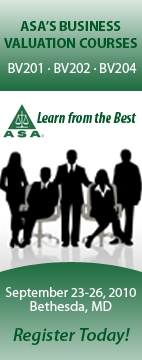
Fairness opinions trending towards “Houlihan Lokey” model During the recent BVR webinar on fairness opinions, Jeffrey Rothschild (McDermott Will & Emory) told the audience there are generally two different models of fairness opinions; one by Goldman Sachs and the other by Houlihan Lokey. The Goldman model is a very short fairness opinion, generally a page-and-a-half, while the Houlihan Lokey model is typically three or four pages. “Houlihan Lokey’s opinion will typically state quite clearly what it is not. Goldman’s will not do that,” says Rothschild. “I think that the trend has certainly been towards Houlihan Lokey’s model in this area and not Goldman Sachs’.” As a subscriber service, BVWire extracted this sample Houlihan Lokey fairness opinion from the SEC EDGAR database. For the complete presentation on fairness opinions click here. Is the market for divorce valuations picking up again? You can find as many reports that the recession is driving up the divorce rate as those that say the economic crisis has caused couples to delay or even decide against their own relationship crisis. We did a quick, informal search on BVLaw™ and found that divorce cases have indeed declined since the first part of the decade. In 2002 to 2003, for example, we found 100 appellate court decisions, which dropped to roughly 80 cases in 2005 to 2006, and then took a sharp down turn in 2007 to 2008 (22 cases) and 2008 to 2009 (18). So far this year, we’ve already reported 24 appellate decisions concerning divorce (does that bode well for the economy?). In fact, we’ll be digesting five divorce cases for this September’s BVUpdate: Two concern the valuation of law practices, two on medical practices, and one examines a variety of closely held and partnership interests, including the applicability of minority and marketability discounts. Where can you get a complete round-up of divorce case law, plus current advice and insights from top judges, attorneys, and appraisal experts from across the country? At BVR/Morningstar’s 3rd Annual Summit on Business Valuation in Divorce, to be held September 13th and 14th in Chicago, under the always candid, always comprehensive co-chair leadership of Jay Fishman and Bill Morrison, with session topics ranging from evidence to discounts to goodwill and more, which you can attend in person or via live webcast. To view the complete agenda, click here. Non-compete vs. personal goodwill: whose asset is In 1980, Larry Howard, DDS, incorporated his practice, becoming the sole shareholder, officer, and director. He also entered a covenant not to compete (in effect, protecting his company from himself). Whatever his objective, when he retired in 2002 and sold his practice to another “corporate” dentist, the parties’ purchase agreement allocated nearly $550,000 to Dr. Howard as personal goodwill and $16,000 for the covenant not to compete. In filing his federal income tax returns that year, Dr. Howard reported just over $320,000 as long-term capital gain resulting from the sale of goodwill. The IRS characterized the goodwill as a corporate asset, however, and treated the dentist’s receipt of $320,000 as a dividend. On review by the federal district court (E.D. Wash.), the taxpayer relied on state divorce law to argue that professional goodwill was a personal asset. Moreover, the purchase agreement had classified it as such and the sale of the company effectively terminated the non-compete. By contrast, the IRS cited Tax Court cases to show that if an employee works under a covenant not to compete, then the company owns the goodwill generated from the professional’s work—and the court ultimately agreed. “The covenant not to compete reinforces the conclusion that Howard Corporation controlled the assets, earned the income from Dr. Howard’s services, and barred Dr. Howard from competing with Howard Corporation.” Read the full digest of Howard v. Commissioner, No. CV-08-365-RMP (July 30, 2010) in the September BVUpdate™. The court’s opinion will soon be available at BVLaw. ADV.
TAF releases first Best Practices monograph on Paula Seidel at The Appraisal Foundation sent us the good news that they released the first monograph in their Best Practices for Valuations in Financial Reporting series last week. The Identification of Contributory Assets and Calculation of Economic Rents is available here. TAF’s monograph series offers voluntary guidance to appraisers, and, to this end, this first monograph also includes a Toolkit that provides illustrative examples. Seidel recognized that both documents are the culmination of several years of research, deliberation and public exposure on the topic of Contributory Assets—and as such she wanted to specifically thank the members of the Working Group on Contributory Assets and their firms who donated their valuable time and resources to this project:
“In 2006, The Appraisal Foundation offered to lend its infrastructure to the process of creating monographs that would be useful in narrowing the diversity in practice in valuations for financial reporting,” said Jay Fishman, Vice Chair of the Appraisal Practices Board and Co-Chair of the Steering Committee on Best Practices for Valuations in Financial Reporting. “It is a credit to the members of the Working Group and everyone else associated with this project that our first monograph is a reality.” The Appraisal Foundation currently has two additional documents being developed by volunteer Working Groups:
For more information on the Valuations in Financial Reporting project or other activities of The Appraisal Foundation, please contact Paula. Willamette Management’s new research on forensic analysis and dispute resolution available The following articles from the most recent issue of Willamette Management Insights (Summer 2010) are available on WMA’s website:
These and the remaining Insight articles will be added to the BVResearch™ library later this year. A reminder of “the basics” in the on-going fair value debate Going Concern’s Adrienne Gonzalez recently asked the question “does anyone care about fair value anymore?” Tired of reading IASB and FASB requests for comments, Gonzalez asked David Larsen (Duff & Phelps and a member of FASB’s Valuation Resource Group) for his current thoughts. “David believes public opinion dominates the fair value argument and really doesn’t see what the big deal is,” comments Gonzales. “The goal is to make financial statements more readable.” Larsen is “a fan of transparency on the face of financial statements and more disclosures. Who doesn’t like that?” asks Gonzalez. Click here for the full article. DLOM webcast today! Get your DLOM questions answered today, August 11, from three of the best. Chris Mercer (Mercer Capital), Kevin Yeanoplos (Brugemman and Johnson Yeanoplos) and James Lurie (Cap-Val LLC) lead the discussion in “Everything You Always Wanted To Know About DLOM But Were Too Afraid To Ask,” a BVR webinar. To sign up, click here. Two CPE credits are available for all your firm’s attendees. Get the latest on the changes in the rules of electronic discovery The rules of electronic discovery are changing, particularly for valuation report drafts. Not understanding the new rules can greatly impair the work of an appraiser or expert witness. At BVR’s 3rd Annual Summit on Business Valuation in Divorce expert Mark Harrison (Meyers Harrison & Pia, LLC) and attorney John Kornfeld (Sheresky Aronson Mayefsky & Sloan, LL)will discuss how best to put these new rules to your advantage and how to protect yourself when working in matrimonial dissolution cases. More information on the BVR 3rd Annual Summit on BV in Divorce is available here.
To ensure this email is delivered to your inbox, Copyright © 2010 by Business Valuation Resources, LLC
|
|




